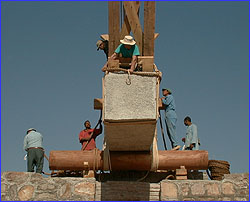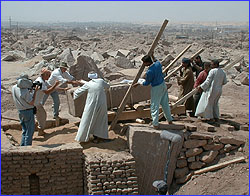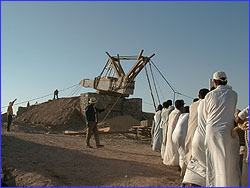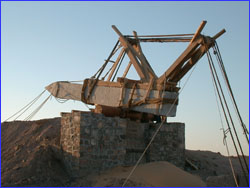
|
 |
 |
by Peter Tyson March 23, 1999 Today we watched two obelisks begin rising toward the sun. First, Roger Hopkins tried out his sand-pit method with the two-ton obelisk. He had it lowered butt-end down into a five-foot-square box he'd had built out of mud bricks and filled with sand. As he and his helpers shoveled sand out of the box through several openings, the obelisk settled slowly down onto its pedestal stone. When we left it in mid-afternoon to begin rotating the large obelisk, the two-tonner had eased into the pedestal's turning groove. Hopkins had successfully demonstrated the sandpit method, which a number of scholars have suggested might have been the way the ancients raised even the largest obelisks. Tomorrow, Hopkins hopes to pull the obelisk upright using ropes. By 3:30, the rope-lashing crew led by Iolo Roberts had finished tying Spanish windlasses and other fancy knots on the big obelisk, and we were ready to get underway with the attempt. Anticipation ran high as 40 laborers brought from the town were split into two groups, 20 along each of two "swigging" ropes. Attached midway along the main ropes sticking down off the timber frame at the obelisk's butt end, the swigging ropes would do the chief work of pulling the pillar up. (See Second Chance.)
Standing on the flat below the ramp, Mark Whitby gave the order to begin. "Hela hop!" went the cry from the 40 pullers as they leaned back on the swigging ropes. The timber beams creaked ominously as ropes cinched down on them, but the obelisk lifted ever so slightly off its rollers. Standing below the butt end of the timber frame, Iolo Roberts and Wyle Brown immediately tightened the main ropes, which the swigging had loosened.
We repeated this process six or eight times before we ran out of time. It was about five o'clock, and the sun was well on its way to the horizon. The call to halt went out. Leaning back on the nearest chunk of granite, I suddenly noticed two things about our obelisk that I hadn't noticed before. First, I was struck by its appearance. The Greeks thought obelisks resembled small spits of land and so called them obeliskos, a Greek diminutive that means just that, a small spit. The Roman encyclopedist Pliny the Elder noted that they were meant to resemble the sun's rays. The Arabic word for them is Messalah, which is a large patching needle. But to me, our half-raised obelisk looked like nothing so much as a missile readying for launch.
Tomorrow at seven, we resume raising our obelisks toward the sun. Will the gods favor us with success? Peter Tyson is Online Producer of NOVA. Obelisk Raised! (September 12) In the Groove (September 1) The Third Attempt (August 27) Angle of Repose (March 25) A Tale of Two Obelisks (March 24) Rising Toward the Sun (March 23) Into Position (March 22) On an Anthill in Aswan (March 21) Ready to Go (March 20) Gifts of the River (March 19) By Camel to a Lost Obelisk (March 18) The Unfinished Obelisk (March 16) Pulling Together (March 14) Balloon Flight Over Ancient Thebes (March 12) The Queen Who Would Be King (March 10) Rock of Ages (March 8) The Solar Barque (March 6) Coughing Up an Obelisk (March 4) Explore Ancient Egypt | Raising the Obelisk | Meet the Team Dispatches | Pyramids | E-Mail | Resources Classroom Resources | Site Map | Mysteries of the Nile Home Editor's Picks | Previous Sites | Join Us/E-mail | TV/Web Schedule About NOVA | Teachers | Site Map | Shop | Jobs | Search | To print PBS Online | NOVA Online | WGBH © | Updated November 2000 |
 Iolo Roberts, middle, oversees final rope-tying late
this morning.
Iolo Roberts, middle, oversees final rope-tying late
this morning.
 With the NOVA camera running, laborers lever the
small obelisk into Roger Hopkins' sand pit.
With the NOVA camera running, laborers lever the
small obelisk into Roger Hopkins' sand pit.
 As Mark Whitby, far left, gives the signal to pull,
the "swiggers" lean into the ropes, causing the
obelisk to rotate ever so slightly.
As Mark Whitby, far left, gives the signal to pull,
the "swiggers" lean into the ropes, causing the
obelisk to rotate ever so slightly.
 The obelisk as it appeared at five o'clock this
afternoon. We resume tomorrow at seven.
The obelisk as it appeared at five o'clock this
afternoon. We resume tomorrow at seven.